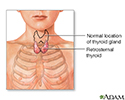Retrosternal thyroid surgery
Substernalthyroid - surgery; Mediastinal goiter - surgery
The thyroid gland is normally located at the front of the neck. A retrosternal thyroid refers to the abnormal location of all or part of the thyroid gland below the breastbone (sternum).
Description
A retrosternal goiter is always a consideration in people who have a mass sticking out of the neck. A retrosternal goiter often causes no symptoms for years. It is often detected when a chest x-ray is done for another reason. Any symptoms are usually due to pressure on nearby structures, such as the windpipe (trachea) and swallowing tube (esophagus).
Goiter
A simple goiter is an enlargement of the thyroid gland. It is usually not a tumor or cancer.

Surgery to completely remove the goiter may be recommended, even if you do not have symptoms.
During the surgery:
- You receive general anesthesia. This makes you asleep and unable to feel pain.
- You lie on your back with your neck slightly extended.
- The surgeon makes a 3 to 4 inch (7.5 to 10 centimeters) surgical cut (incision) in your neck to determine if the mass can be removed without opening the chest. Most of the time, the surgery can be done this way.
- If the mass is deep inside the chest, the surgeon makes an incision along the middle of your chest bone. The entire goiter is then removed.
- A tube may be left in place to drain fluid and blood. It is usually removed in 1 to 2 days.
- The incisions are closed with stitches (sutures).
Why the Procedure is Performed
This surgery is done to completely remove the mass. If it is not removed, it can put pressure on your trachea and esophagus.
If the retrosternal goiter has been there for a long time, you can have difficulty swallowing food, mild pain in the neck area, or shortness of breath.
Risks
Risks of anesthesia and surgery in general are:
- Reactions to medicines, breathing problems
- Bleeding, blood clots, infection
Risks of retrosternal thyroid surgery are:
- Damage to parathyroid glands (small glands near the thyroid) or to their blood supply, resulting in low calcium
- Damage to the trachea
- Perforation of the esophagus
- Vocal cord injury
Before the Procedure
During the weeks before your surgery:
- You may need to have tests that show exactly where your thyroid gland is located. This will help the surgeon find the thyroid during surgery. You may have a CT scan, ultrasound, or other imaging tests.
- You may also need thyroid medicine or iodine treatments 1 to 2 weeks before surgery.
Tell your provider about all the medicines you take, even those bought without a prescription. This includes herbs and supplements.
Several days to a week before surgery:
- You may be asked to stop taking medicines that make it harder for your blood to clot. These include aspirin, ibuprofen (Advil), naproxen (Aleve), clopidogrel (Plavix), warfarin (Coumadin).
- Fill any prescriptions for pain medicine and calcium you will need after surgery.
- Tell your provider about all the medicines you take, even those bought without a prescription. This includes herbs and supplements. Ask your provider which medicines you should still take on the day of surgery.
- If you smoke, try to stop. Ask your provider for help.
On the day of surgery:
- Follow instructions about when to stop eating and drinking.
- Take any medicines that your provider told you to take with a small sip of water.
- Be sure to arrive at the hospital on time.
After the Procedure
You may need to stay in the hospital overnight after surgery so a nurse can watch for any bleeding, change in calcium level, or breathing problems.
You may go home the next day if the surgery was done through the neck. If the chest was opened up, you may stay in hospital for several days.
You will likely be able to get up and walk on the day after surgery. It should take about 3 to 4 weeks for you to fully recover.
You may have pain after surgery. Ask your provider for instructions on how to take pain medicines after you go home.
Follow any instructions for taking care of yourself after you go home.
Instructions
You had surgery to remove part or all of your thyroid gland. This operation is called thyroidectomy. You probably spent 1 to 3 days in the hospital....
Outlook (Prognosis)
Outcome of this surgery is usually excellent. Most people need to take thyroid hormone pills (thyroid hormone replacement) for the rest of their lives when the whole gland is removed.
References
Kaplan EL, Angelos P, James BC, Nagar S, Grogan RH. Surgery of the thyroid. In: Jameson JL, De Groot LJ, de Kretser DM, et al, eds. Endocrinology: Adult and Pediatric . 7th ed. Philadelphia, PA: Elsevier Saunders; 2016:chap 96.
Smith PW, Salomone LJ, Hanks JB. Thyroid. In: Townsend CM Jr, Beauchamp RD, Evers BM, Mattox KL, eds. Sabiston Textbook of Surgery . 19th ed. Philadelphia, PA: Elsevier Saunders; 2012:chap 38.
-
Retrosternal thyroid - illustration
The normal position of the thyroid is at the front of the neck above the sternal notch. In retrosternal thyroid, a portion of the gland extends below the sternal notch.
Retrosternal thyroid
illustration
Review Date: 2/27/2016
Reviewed By: Debra G. Wechter, MD, FACS, general surgery practice specializing in breast cancer, Virginia Mason Medical Center, Seattle, WA. Also reviewed by David Zieve, MD, MHA, Isla Ogilvie, PhD, and the A.D.A.M. Editorial team.

